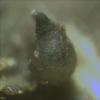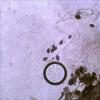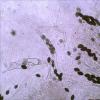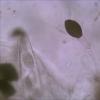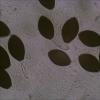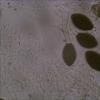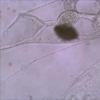
30-11-2025 12:53
 Edvin Johannesen
Edvin Johannesen
White short-stipitate apothecia found on thin twig

30-11-2025 10:47
 William Slosse
William Slosse
I recently found a collection of small Peziza sp.

27-11-2025 12:01
Thomas Læssøehttps://svampe.databasen.org/observations/10496727

27-11-2025 11:46
Thomas Læssøehttps://svampe.databasen.org/observations/10493918

17-09-2025 10:50
Heather MerryleesHi there!I am hoping for any advice on the identif

29-11-2025 08:40
 Andreas Millinger
Andreas Millinger
Hello,on a splintered part of a branch on the grou

28-11-2025 16:45
Nogueira HéctorNovember 23, 2025 Requejo de Sanabria (León) SPAI

25-11-2025 14:24
Thomas Læssøehttps://svampe.databasen.org/observations/10490522

27-11-2025 15:41
Thomas LæssøeSpores brownish, typically 4-celled; 26.8 x 2.4;

27-11-2025 11:31
Thomas LæssøeCollectors notes: Immersed ascomata, erumpent thro
Podospora pyriformis?
Joop van der Lee,
08-12-2014 21:44
 Found on cow dung.
Found on cow dung.Asci: 8-spored; quickly expand in water 440-616x39-105 um.
Spores: Uniseriate soon becoming biseriate; pedicel curved 45.5-49x8-9 um, transversly septated; upper cauda covering germ pore; secondary cauda attached to distel end of pedicel; spores oval, 40-44x25-26.5 um.
Instead of an upper cauda something else was connected at the sporehead inside the ascus that I do not know (photo-8)
Piotr Perz,
08-12-2014 21:52
Re : Podospora pyriformis?
Dear Joop,
Photo 8: IMHO the ascospore is germinating.
Regards
Piotr
Photo 8: IMHO the ascospore is germinating.
Regards
Piotr
Joop van der Lee,
08-12-2014 22:14

Re : Podospora pyriformis?
Thanks Piotr
Francisco Calaça,
08-12-2014 22:49
Re : Podospora pyriformis?
Hi Joop, how're you? Fine?
Well, your Podospora is like P. pyriformes in some aspects, mainly in the atypical septate spore. But P. pyriformis, the upper cauda not cover the germ pore. You're right? Cuz the septate spore is very common on this kind... You have pics of the ascus type? According Bell (1983) this specie grow on old dung. It's your case? I bet on this :)
Can you send more details?
With my best regards,
Francisco Calaça.
Well, your Podospora is like P. pyriformes in some aspects, mainly in the atypical septate spore. But P. pyriformis, the upper cauda not cover the germ pore. You're right? Cuz the septate spore is very common on this kind... You have pics of the ascus type? According Bell (1983) this specie grow on old dung. It's your case? I bet on this :)
Can you send more details?
With my best regards,
Francisco Calaça.
